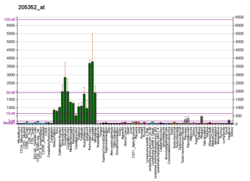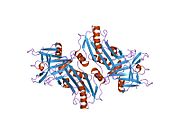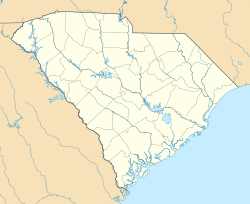신경 서핀
Neuroserpin| 서피니1 | |||||||||||||||||||||||||
|---|---|---|---|---|---|---|---|---|---|---|---|---|---|---|---|---|---|---|---|---|---|---|---|---|---|
 | |||||||||||||||||||||||||
| |||||||||||||||||||||||||
| 식별자 | |||||||||||||||||||||||||
| 에일리어스 | SERPINI1, PI12, neuro serpin, serpin 패밀리I 멤버1, HNS-S2, HNS-S1 | ||||||||||||||||||||||||
| 외부 ID | OMIM: 602445 MGI: 1194506 HomoloGene: 21045 Genecards: SERPINI1 | ||||||||||||||||||||||||
| |||||||||||||||||||||||||
| |||||||||||||||||||||||||
| |||||||||||||||||||||||||
| |||||||||||||||||||||||||
| 맞춤법 | |||||||||||||||||||||||||
| 종. | 인간 | 마우스 | |||||||||||||||||||||||
| 엔트레즈 | |||||||||||||||||||||||||
| 앙상블 | |||||||||||||||||||||||||
| 유니프로트 | |||||||||||||||||||||||||
| RefSeq(mRNA) | |||||||||||||||||||||||||
| RefSeq(단백질) | |||||||||||||||||||||||||
| 장소(UCSC) | Chr 3: 167.74 ~167.83 Mb | Chr 3: 75.46 ~75.55 Mb | |||||||||||||||||||||||
| PubMed 검색 | [3] | [4] | |||||||||||||||||||||||
| 위키데이터 | |||||||||||||||||||||||||
| |||||||||||||||||||||||||
Neuro serpin은 SERPI1 [5]유전자에 의해 인간에게 암호화되는 단백질이다.
그것은 신경 서핀포함체를 가진 가족성 뇌증과 관련이 있다.
셀핀 슈퍼패밀리의 세린단백질가수분해효소억제제는 많은 세포과정에 관여한다.신경 서핀은 배근 신경절 뉴런의 축삭에서 분비되는 단백질로 처음 확인되었다(Stoeckli et al., 1989).그것은 시냅스 형성 과정에서의 신경 생성의 후반 단계에서 발현된다.[OMIM [5]제공]
상호 작용
SERPINI1은 조직 플라스미노겐 [6]활성제와 상호작용하는 것으로 나타났다.
레퍼런스
- ^ a b c GRCh38: 앙상블 릴리즈 89: ENSG00000163536 - 앙상블, 2017년 5월
- ^ a b c GRCm38: 앙상블 릴리즈 89: ENSMUSG000027834 - 앙상블, 2017년 5월
- ^ "Human PubMed Reference:". National Center for Biotechnology Information, U.S. National Library of Medicine.
- ^ "Mouse PubMed Reference:". National Center for Biotechnology Information, U.S. National Library of Medicine.
- ^ a b "Entrez Gene: SERPINI1 serpin peptidase inhibitor, clade I (neuroserpin), member 1".
- ^ Parmar, Parmjeet K; Coates Leigh C; Pearson John F; Hill Rena M; Birch Nigel P (September 2002). "Neuroserpin regulates neurite outgrowth in nerve growth factor-treated PC12 cells". J. Neurochem. 82 (6): 1406–15. doi:10.1046/j.1471-4159.2002.01100.x. ISSN 0022-3042. PMID 12354288. S2CID 23571680.
추가 정보
- Yepes M; Lawrence DA (2004). "Neuroserpin: a selective inhibitor of tissue-type plasminogen activator in the central nervous system". Thromb. Haemost. 91 (3): 457–64. doi:10.1160/TH03-12-0766. PMID 14983220.
- Schrimpf SP, Bleiker AJ, Brecevic L, et al. (1997). "Human neuroserpin (PI12): cDNA cloning and chromosomal localization to 3q26". Genomics. 40 (1): 55–62. doi:10.1006/geno.1996.4514. PMID 9070919.
- Hastings GA, Coleman TA, Haudenschild CC, et al. (1998). "Neuroserpin, a brain-associated inhibitor of tissue plasminogen activator is localized primarily in neurons. Implications for the regulation of motor learning and neuronal survival". J. Biol. Chem. 272 (52): 33062–7. doi:10.1074/jbc.272.52.33062. PMID 9407089.
- Davis RL, Shrimpton AE, Holohan PD, et al. (1999). "Familial dementia caused by polymerization of mutant neuroserpin". Nature. 401 (6751): 376–9. doi:10.1038/43894. PMID 10517635. S2CID 4413322.
- Chang WS, Chang NT, Lin SC, et al. (2000). "Tissue-specific cancer-related serpin gene cluster at human chromosome band 3q26". Genes Chromosomes Cancer. 29 (3): 240–55. doi:10.1002/1098-2264(2000)9999:9999<::AID-GCC1029>3.0.CO;2-A. PMID 10992299.
- Belorgey D; Crowther DC; Mahadeva R; Lomas DA (2002). "Mutant Neuroserpin (S49P) that causes familial encephalopathy with neuroserpin inclusion bodies is a poor proteinase inhibitor and readily forms polymers in vitro". J. Biol. Chem. 277 (19): 17367–73. doi:10.1074/jbc.M200680200. PMID 11880376.
- Davis RL, Shrimpton AE, Carrell RW, et al. (2002). "Association between conformational mutations in neuroserpin and onset and severity of dementia". Lancet. 359 (9325): 2242–7. doi:10.1016/S0140-6736(02)09293-0. PMID 12103288. S2CID 10722760.
- Barker-Carlson K; Lawrence DA; Schwartz BS (2003). "Acyl-enzyme complexes between tissue-type plasminogen activator and neuroserpin are short-lived in vitro". J. Biol. Chem. 277 (49): 46852–7. doi:10.1074/jbc.M207740200. PMID 12228252.
- Parmar PK, Coates LC, Pearson JF, et al. (2002). "Neuroserpin regulates neurite outgrowth in nerve growth factor-treated PC12 cells". J. Neurochem. 82 (6): 1406–15. doi:10.1046/j.1471-4159.2002.01100.x. PMID 12354288. S2CID 23571680.
- Strausberg RL, Feingold EA, Grouse LH, et al. (2003). "Generation and initial analysis of more than 15,000 full-length human and mouse cDNA sequences". Proc. Natl. Acad. Sci. U.S.A. 99 (26): 16899–903. Bibcode:2002PNAS...9916899M. doi:10.1073/pnas.242603899. PMC 139241. PMID 12477932.
- Miranda E; Römisch K; Lomas DA (2004). "Mutants of neuroserpin that cause dementia accumulate as polymers within the endoplasmic reticulum". J. Biol. Chem. 279 (27): 28283–91. doi:10.1074/jbc.M313166200. PMID 15090543.
- Teesalu T, Kulla A, Simisker A, et al. (2005). "Tissue plasminogen activator and neuroserpin are widely expressed in the human central nervous system". Thromb. Haemost. 92 (2): 358–68. doi:10.1160/TH02-12-0310. PMID 15269833.
- Belorgey D, Sharp LK, Crowther DC, et al. (2004). "Neuroserpin Portland (Ser52Arg) is trapped as an inactive intermediate that rapidly forms polymers: implications for the epilepsy seen in the dementia FENIB". Eur. J. Biochem. 271 (16): 3360–7. doi:10.1111/j.1432-1033.2004.04270.x. PMID 15291813.
- Gerhard DS, Wagner L, Feingold EA, et al. (2004). "The status, quality, and expansion of the NIH full-length cDNA project: the Mammalian Gene Collection (MGC)". Genome Res. 14 (10B): 2121–7. doi:10.1101/gr.2596504. PMC 528928. PMID 15489334.
- Onda M; Belorgey D; Sharp LK; Lomas DA (2005). "Latent S49P neuroserpin forms polymers in the dementia familial encephalopathy with neuroserpin inclusion bodies". J. Biol. Chem. 280 (14): 13735–41. doi:10.1074/jbc.M413282200. PMID 15664988.
- Rual JF, Venkatesan K, Hao T, et al. (2005). "Towards a proteome-scale map of the human protein-protein interaction network". Nature. 437 (7062): 1173–8. Bibcode:2005Natur.437.1173R. doi:10.1038/nature04209. PMID 16189514. S2CID 4427026.
- Kinghorn KJ, Crowther DC, Sharp LK, et al. (2006). "Neuroserpin binds Abeta and is a neuroprotective component of amyloid plaques in Alzheimer disease". J. Biol. Chem. 281 (39): 29268–77. doi:10.1074/jbc.M600690200. PMID 16849336.
- Chen PY, Chang WS, Chou RH, et al. (2007). "Two non-homologous brain diseases-related genes, SERPINI1 and PDCD10, are tightly linked by an asymmetric bidirectional promoter in an evolutionarily conserved manner". BMC Mol. Biol. 8: 2. doi:10.1186/1471-2199-8-2. PMC 1796892. PMID 17212813.
- Gourfinkel-An I, Duyckaerts C, Camuzat A, et al. (2007). "Clinical and neuropathologic study of a French family with a mutation in the neuroserpin gene". Neurology. 69 (1): 79–83. doi:10.1212/01.wnl.0000265052.99144.b5. PMID 17606885. S2CID 39704442.








